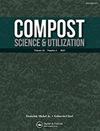在德克萨斯州北部高原区混合使用生牛粪和无机肥料对玉米产量和土壤肥力的影响
IF 0.9
4区 农林科学
Q3 ECOLOGY
引用次数: 7
摘要
在德克萨斯高平原,每年大约饲养700万头肉牛,产生1600万毫克的粪肥,这些粪肥作为生粪肥(RM)用于农作物的土地施用。对好氧堆肥的兴趣促使了一项为期2年的实地研究,主要目的是评估与堆肥(CM)相比,RM玉米(Zea mays L.)的产量和土壤肥力。4种处理(TRT)分别为低速率堆肥(CM-L)、高速率堆肥(CM-H)、RM和无机肥(IN)。通过向RM和CM补充氮素,所有4个TRT获得了相同的植株有效氮素。采用机器采收和人工采收两种方法测定产量。机收产量在两年内与TRT相似。灌溉水第一年的手采产量低于常规灌溉水,灌溉水第二年的手采产量与常规灌溉水相近。由于干旱,所有TRT第二年的产量都明显下降。2年后,CM-H土壤P、K、Zn和有机碳浓度高于IN,不同TRT土壤NO3-N、pH和电导率无差异。CM和RM都为玉米生产和提高土壤肥力提供了有益养分。在德克萨斯高平原地区,土壤改良和土壤改良对土壤健康和可持续性有长期的好处。本文章由计算机程序翻译,如有差异,请以英文原文为准。
Corn Yield and Soil Fertility with Combined Use of Raw or Composted Beef Manure and Inorganic Fertilizers on the Texas Northern High Plains
ABSTRACT About 7 million beef cattle are raised annually in the Texas High Plains, producing 16 million Mg of manure, which is land-applied as raw manure (RM) to crops. An interest in aerobic composting prompted a 2-year field study with the primary objective of evaluating corn (Zea mays L.) yield and soil fertility for RM as compared to composted manure (CM). The four treatments (TRT) consisted of low-rate composted manure (CM-L), high-rate composted manure (CM-H), RM, and inorganic fertilizer (IN). All four TRT received equal plant—available N by supplementing the RM and CM with IN. Yield was measured by both machine-harvesting and hand-harvesting methods. Machine-harvested yield was similar among TRT for both years. Hand-harvested yield was lower for IN than RM in the first year, with similar yields among TRT in the second year. Due to drought, yields were considerably lower in the second year for all TRT. After 2 years, CM-H had higher soil P, K, Zn, and organic carbon concentrations than IN, with no differences among TRT for soil NO3-N, pH, or electrical conductivity. Both CM and RM provided beneficial nutrients for corn production and improving soil fertility. Land application of CM and RM provides long-term benefits to soil health and sustainability in the Texas High Plains region.
求助全文
通过发布文献求助,成功后即可免费获取论文全文。
去求助
来源期刊

Compost Science & Utilization
农林科学-生态学
CiteScore
4.10
自引率
0.00%
发文量
0
审稿时长
>36 weeks
期刊介绍:
4 issues per year
Compost Science & Utilization is currently abstracted/indexed in: CABI Agriculture & Environment Abstracts, CSA Biotechnology and Environmental Engineering Abstracts, EBSCOhost Abstracts, Elsevier Compendex and GEOBASE Abstracts, PubMed, ProQuest Science Abstracts, and Thomson Reuters Biological Abstracts and Science Citation Index
 求助内容:
求助内容: 应助结果提醒方式:
应助结果提醒方式:


